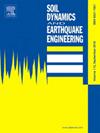可液化土壤中表面粗糙度不同的隧道地震行为实验研究
IF 4.2
2区 工程技术
Q1 ENGINEERING, GEOLOGICAL
引用次数: 0
摘要
地震引起的液化对地下结构构成严重的安全风险。本研究通过 1g 振动台试验研究了位于可液化土壤中的两部分隧道的上浮行为和土-结构相互作用(SSI),并特别关注了结构表面粗糙度的影响。进行了两次平行试验,包括自由场试验和土壤-隧道试验,以研究各种输入运动诱发液化时的现场响应和 SSI 的影响。试验结果表明,在第一次震动事件中,地面部分液化,随后在加载振幅更大、加载持续时间更长的事件中,地面完全液化。由于隧道的存在,隧道周围的过大孔隙压力和水平加速度响应发生了显著变化,这也导致隧道附近加速度放大和应变发展的不同模式。虽然结构表面粗糙度在一定程度上影响了上述响应,但它在隧道的上浮行为中起着更主要的作用。表面粗糙度较低的区段与表面粗糙度较高的区段相比,隆起明显更大。此外,研究还发现,结构隆起行为可分为不同的阶段,这些阶段具有不同的孔隙压力发展模式,在不同的加载条件下,这种行为也明显不同。这项研究结果强调了在未来的数值或实验研究中考虑表面粗糙度的重要性,以便更好地捕捉结构隆起。本文章由计算机程序翻译,如有差异,请以英文原文为准。
Experimental study on the seismic behavior of tunnels with distinct surface roughness in liquefiable soils
Earthquake-induced liquefaction poses grave safety risks to the underground structures. In this study, 1-g shaking table tests were conducted to investigate the uplift behaviors and soil-structure interaction (SSI) of a two-part tunnel located in liquefiable soils, with special attention paid to the influence of structural surface roughness. Two parallel tests, including a free-field test and a soil-tunnel test, were carried out to investigate the field responses and the effect of SSI during liquefaction induced by various input motions. The test results indicate that the ground partially liquefied during the first shaking event, and then experienced full liquefaction in the subsequent events with higher loading amplitude and longer loading duration. The excess pore pressure and horizontal acceleration responses around the tunnel were significantly altered due to the presence of the tunnel, which also led to different patterns of acceleration amplification and strain development in its vicinity. While structural surface roughness influenced the aforementioned responses to some extent, it played a more dominant role in the uplift behavior of the tunnel. The segment with lower surface roughness experienced significantly greater uplift compared to the rougher counterpart. Furthermore, it was found that the structural uplift behavior can be divided into distinct stages that feature different patterns of pore pressure development, and such behavior was notably different under varied loading conditions. The findings in this research emphasize the importance of incorporating the considerations of surface roughness in future numerical or experimental studies so that the structural uplift can be better captured.
求助全文
通过发布文献求助,成功后即可免费获取论文全文。
去求助
来源期刊

Soil Dynamics and Earthquake Engineering
工程技术-地球科学综合
CiteScore
7.50
自引率
15.00%
发文量
446
审稿时长
8 months
期刊介绍:
The journal aims to encourage and enhance the role of mechanics and other disciplines as they relate to earthquake engineering by providing opportunities for the publication of the work of applied mathematicians, engineers and other applied scientists involved in solving problems closely related to the field of earthquake engineering and geotechnical earthquake engineering.
Emphasis is placed on new concepts and techniques, but case histories will also be published if they enhance the presentation and understanding of new technical concepts.
 求助内容:
求助内容: 应助结果提醒方式:
应助结果提醒方式:


